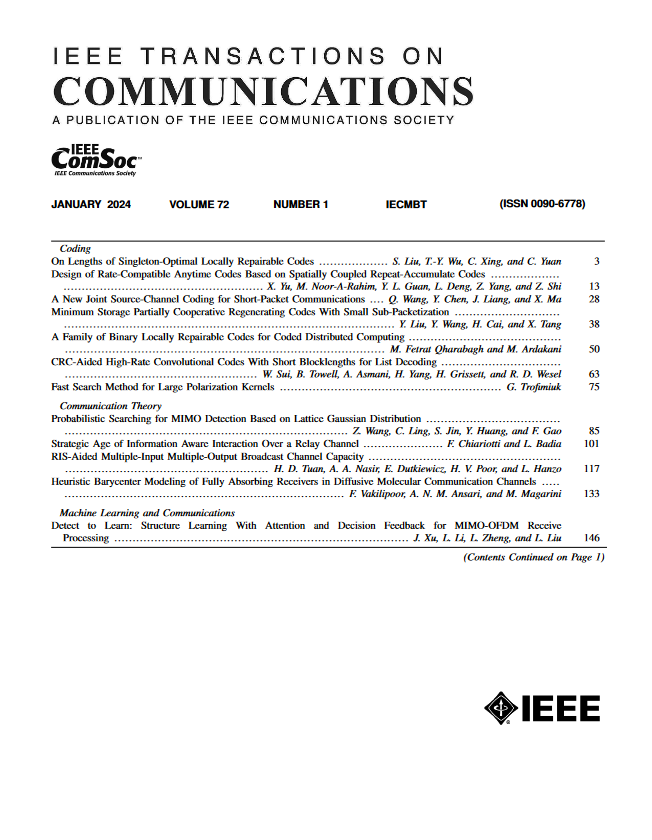Age of Information in Gossip Networks: A Friendly Introduction and Literature Survey
IF 8.3
2区 计算机科学
Q1 ENGINEERING, ELECTRICAL & ELECTRONIC
引用次数: 0
Abstract
Gossiping is a communication mechanism, used for fast information dissemination in a network, where each node of the network randomly shares its information with the neighboring nodes. To characterize the notion of fastness in the context of gossip networks, age of information (AoI) is used as a timeliness metric. In this article, we summarize the recent works related to timely gossiping in a network. We start with the introduction of randomized gossip algorithms as an epidemic algorithm for database maintenance, and how the gossiping literature was later developed in the context of rumor spreading, message passing and distributed mean estimation. Then, we motivate the need for timely gossiping in applications such as source tracking and decentralized learning. We evaluate timeliness scaling of gossiping in various network topologies, such as, fully connected, ring, grid, generalized ring, hierarchical, and sparse asymmetric networks. We discuss age-aware gossiping and the higher order moments of the age process. We also consider different variations of gossiping in networks, such as, file slicing and network coding, reliable and unreliable sources, information mutation, different adversarial actions in gossiping, and energy harvesting sensors. Finally, we conclude this article with a few open problems and future directions in timely gossiping.信息时代的八卦网络:一个友好的介绍和文献调查特邀论文
八卦是一种在网络中用于快速传播信息的通信机制,网络中的每个节点随机地与相邻节点共享其信息。为了在八卦网络的背景下描述快速性的概念,信息时代(AoI)被用作时效性度量。在这篇文章中,我们总结了最近与网络中的及时八卦相关的工作。我们首先介绍了随机八卦算法作为一种流行的数据库维护算法,以及八卦文献后来如何在谣言传播、消息传递和分布均值估计的背景下发展起来。然后,我们在源跟踪和分散学习等应用程序中激发对及时八卦的需求。我们评估了各种网络拓扑中八卦的时效性尺度,如全连接网络、环形网络、网格网络、广义环形网络、分层网络和稀疏非对称网络。我们讨论年龄感知八卦和年龄过程的高阶时刻。我们还考虑了网络中八卦的不同变化,例如文件切片和网络编码,可靠和不可靠的来源,信息突变,八卦中的不同对抗行为以及能量收集传感器。最后,我们总结了一些悬而未决的问题和未来的发展方向。
本文章由计算机程序翻译,如有差异,请以英文原文为准。
求助全文
约1分钟内获得全文
求助全文
来源期刊

IEEE Transactions on Communications
工程技术-电信学
CiteScore
16.10
自引率
8.40%
发文量
528
审稿时长
4.1 months
期刊介绍:
The IEEE Transactions on Communications is dedicated to publishing high-quality manuscripts that showcase advancements in the state-of-the-art of telecommunications. Our scope encompasses all aspects of telecommunications, including telephone, telegraphy, facsimile, and television, facilitated by electromagnetic propagation methods such as radio, wire, aerial, underground, coaxial, and submarine cables, as well as waveguides, communication satellites, and lasers. We cover telecommunications in various settings, including marine, aeronautical, space, and fixed station services, addressing topics such as repeaters, radio relaying, signal storage, regeneration, error detection and correction, multiplexing, carrier techniques, communication switching systems, data communications, and communication theory. Join us in advancing the field of telecommunications through groundbreaking research and innovation.
 求助内容:
求助内容: 应助结果提醒方式:
应助结果提醒方式:


